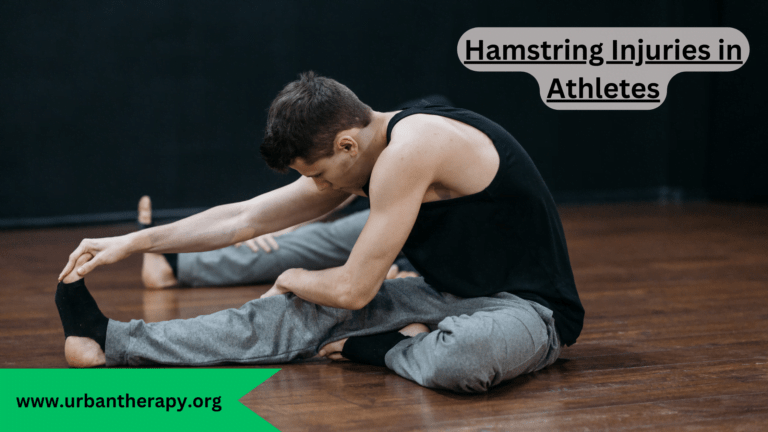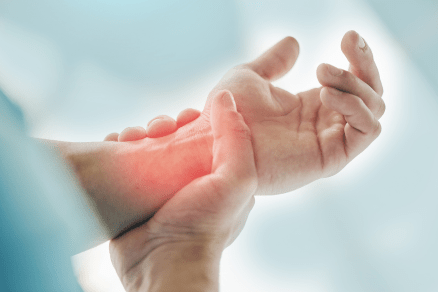Do your hamstrings feel uncomfortably tight, limiting your ability to move freely and causing aching pain? For many Americans, stiff, shortened hamstring muscles are a common problem stemming from various causes like posture, inactivity, sports injuries, and underlying conditions. Read on to understand why your hamstrings get tight, how to identify symptoms, and most importantly, get tips to relieve tight hamstrings through stretches, lifestyle changes, and professional treatment if required.
Having chronically tight hamstrings not only restricts performance in sports and exercises but also increases the risk of painful strains and tears from constantly tense muscles. Additionally, the referred pain from tight hamstrings can radiate down to the knees or up into the lower back. Learning to manage tight hamstrings is crucial for maintaining an active, healthy lifestyle.
What Are the Hamstrings?
The hamstrings are a group of three large, powerful muscles located at the back of the thigh that enable key movements of the hip and knee joints.
Anatomically, the hamstrings originate at the bottom of the pelvis and run down the back of the thigh, crossing both the hip and knee joints before attaching to the lower leg bones.
The three hamstring muscles are:
- Biceps femoris – located on the outer thigh
- Semitendinosus – middle thigh
- Semimembranosus – inner thigh
Together, these three muscles work to flex the knee, extend the hip, and rotate the lower leg. They allow you to walk, run, jump, squat, bend down, and move your leg backward behind you.
The hamstrings play a crucial role in stabilising the pelvis and controlling motions during exercise and athletic activities. They counterbalance the pull of the quadriceps muscles on the front of the thighs.
When the hamstring muscles shorten and tighten excessively, it severely impacts mobility and increases strain and risk of injury during exercise or everyday activities like climbing stairs, getting up from a chair, or reaching down to tie shoes.
Persistent tightness leads to muscle imbalances, poor posture, reduced joint range of motion, and discomfort. It’s important to regularly stretch and properly strengthen the hamstrings to maintain optimal flexibility and function.
What causes tight hamstrings?
There are several reasons why people experience persistent tightness and stiffness in their hamstring muscles. Here are some of the most common causes:
Poor Posture Over Time
Poor posture habits like slouching at a desk job or hunching over laptops and phones can shorten the hamstrings. Staying in these positions for prolonged periods trains the muscles to remain in a shortened position. Over time, this adaptive shortening leads to persistent tightness. Additionally, the resulting muscle imbalances between the front and back of the legs also contribute to hamstring tightness.
Inactivity and Prolonged Sitting
Being inactive and sitting for long periods during the day allows the hamstring muscles to stiffen up and lose flexibility. Extended sitting, such as at an office job or while driving for long stretches, fails to fully extend the hips and knees through their full range of motion. This immobility causes the muscles to tighten.
High-Intensity or Improper Exercise
Overdoing certain exercises and physical activities can overwork the hamstrings and cause tiny tears in the muscle fibres, leading to soreness and tightness. High-intensity interval training, running long distances, or playing sports that involve sprinting and running overwork the hamstrings. Improper strength training techniques and poor form doing exercises like deadlifts can also strain the delicate hamstring muscles.
Prior Hamstring Injury
Suffering any type of hamstring muscle strain or tear often results in residual tightness long after the injury site has healed. The body tends to stabilise and protect previously injured areas by tightening up the surrounding muscles. If not properly rehabilitated through stretching and strengthening protocols, this compensatory tightness can become chronic.
Age-Related Changes
As we age, muscles lose flexibility and elasticity due to less physical activity. Age-related changes to posture, such as increased thoracic kyphosis and hip flexion from arthritis, also contribute to tight hamstrings in seniors.
Excess Weight
Carrying excess body weight coupled with a sedentary, unhealthy lifestyle greatly contributes to inflexible, tight hamstrings. The extra mass carried on the frame increases strain on the posterior thigh muscles, especially when standing or moving from sitting to standing.
Dehydration and Nutritional Deficiencies
Lack of fluids and electrolytes like sodium, potassium, and magnesium required for normal muscle contraction and relaxation can cause painful cramping and progressive tightness. Deficiency in minerals like calcium and iron as well as vitamins E, D, B1, B6, and omega-3s needed for tissue repair and growth, can also contribute to muscle tightness.
Underlying Conditions
In rare cases, persistent tight hamstrings may indicate an underlying nerve compression issue like a disk herniation or spinal stenosis impinging the sciatic nerve. Pre-existing conditions like osteoarthritis, adhesive capsulitis, plantar fasciitis, diabetes leading to neuropathy, and muscle fibrosis from injuries can all cause secondary muscle tightness.
What are tight hamstring symptoms?
There are several clear signs and symptoms that can indicate if your hamstring muscles are excessively tight and short:
- Difficulty bending down to touch your toes or the floor while keeping the legs straight. You may only reach your knees or mid-shin level.
- Stiffness, tightness, and mild pain in the back of the thighs while doing regular activities like squatting, lunging, walking up stairs, etc. Progressively worsens through the day.
- Reduced range of motion and flexibility in the hip joint prevent you from extending your legs backward fully while lying down.
- Limited range of motion and discomfort in knee flexion while sitting for prolonged periods, indicating tightness in the hamstrings crossing the knee joint.
- Frequent sudden, involuntary cramps and spasms in the hamstrings that may last several minutes, especially during exercise.
- A constant mild, dull ache in the hamstring muscle belly and attachment points was felt during rest.
- Tightness and referred pain in the lower back due to the lumbar attachments of the hamstrings.
- Referred to aching and tightness in the back of the knee due to the hamstring insertions around the knee joint.
- Reduced performance in athletic activities like shortened stride length or slower pace when running or sprinting.
- Discomfort and tightness in the hamstrings while sitting for long periods with knees flexed, for example, in deep squat sitting.
- Walking with a restricted, shorter gait and feeling tightness when you attempt to straighten and extend the leg backward fully.
If you experience these symptoms regularly and feel like your flexibility is compromised, get your hamstrings adequately assessed. A physical therapist or athletic trainer can evaluate muscle length and confirm if you have excessive tightness. They may use standard tests like the sit-and-reach or active knee extension tests. Addressing hamstring tightness early helps prevent future mobility restrictions and injury
How to loosen tight hamstrings?
As a licensed physical therapist with over ten years of experience, I frequently help patients find relief from chronically tight, painful hamstrings. Here are my top 10 tips for conservative self-care treatments you can try at home before seeing a doctor:
1. Stretching Exercises for Hamstring
Gentle, sustained stretching targeting the hamstrings for short bursts multiple times a day can provide tremendous relief for tightness. Avoid overstretching to the point of pain. Some easy stretches include:
- Standing hamstring stretch: Put one leg forward on a high stool. Keep the back leg straight and place your hands on your hips. Slowly bend your front hip, keeping the back straight to feel a gentle pull in the back of the elevated leg. Hold for 30 seconds, relax, and repeat a few times on both sides.
- Seated hamstring stretch: Sit on the floor with your legs extended in front. Bend one knee and pull back to your chest. Straighten the other leg, keeping the knee locked. Lean forward from the hip, keeping the back straight to stretch the hamstring of the extended leg. Hold for 30 seconds, relax, and repeat on the other side.
- Towel hamstring stretch: Sit with your leg extended in front. Wrap a towel or strap around the ball of your foot. Clasp both ends of the towel in your hands. Gently pull back, raising your leg to feel a stretch in the hamstring without pain.
- Supine hamstring stretch: Lie on your back, bend one knee, and extend the other leg straight up. Loop a strap around the ball of your foot and gently extend your leg to stretch the hamstring
- Yoga poses like Downward Facing Dog, Standing Forward Fold, Low Lunge, and Pyramid Pose. Use items like yoga blocks to assist flexibility.
2. Improve Flexibility with Foam Rolling
Using a foam roller to self-massage and apply pressure to the tight hamstrings increases blood circulation, relaxes the muscles, and allows for a greater range of motion with regular use. Roller exercises like gentle hamstring rolls, sciatic nerve flossing, and hip opening motions on the roller can improve flexibility. Foam rollers can be purchased affordably at sporting goods stores or online.
3. Perform Hamstring Strengthening Exercises
Strong, flexible hamstring muscles are less prone to tightness and strains. Try hamstring bridges, heel slides, prone leg curls, eccentric decline squats, and resistance band exercises 2-3 times per week. Maintain proper form, limiting weight and reps to avoid injury. Smooth, controlled motions are key. Resistance bands are a great way to strengthen hamstrings conveniently.
4. Warm Up and Cool Down
Dedicate 5-10 minutes to warm up the major muscle groups with light cardio and dynamic stretches before any strenuous physical activity. Cool down with gentle hamstring and calf stretches, too. This prevents delayed onset muscle soreness (DOMS) related tightness. Do some walking lunges or knee lifts to warm your hamstrings before a workout.
5. Consider Massage Therapy
Regular professional deep tissue massage, myofascial release techniques, trigger point therapy, and Active Release Technique (ART) performed by a licensed massage therapist can relieve built-up tension, adhesions, scar tissue, and spasms in the hamstrings. This helps relieve tightness and encourages proper muscle mechanics. Many times, insurance plans will cover massage therapy.
6. Practice Yoga Regularly
A consistent yoga practice combining poses like Forward Folds, Frog Pose, Supine Hamstring Stretch, and Happy Baby with deep breathing increases flexibility by safely stretching the hamstrings and promoting relaxation. Both the stretches and meditative approach in yoga help reduce muscle tension. Local gyms, studios, and apps provide yoga classes.
7. Improve Ergonomics and Posture
Reduce prolonged sitting during work hours and take frequent breaks for light walking to combat a sedentary lifestyle. Use ergonomic chairs, portable lumbar supports, and standing desks. Stretch your hip flexors and strengthen your core. Improve rounded shoulder posture with regular upper back mobility exercises.
8. Apply Heat and Ice
Use heat packs, warm baths, or warm compresses before any activity to relax and loosen up tight hamstrings. For swollen, tender hamstrings indicating a muscle strain, apply ice packs for 10-15 minutes multiple times a day to reduce inflammation. Or alternate heat and ice
9. Stay Hydrated and Fuel Muscles
Drink enough water and electrolyte drinks to stay hydrated. Get sufficient protein to help muscles recover. Reduce muscle inflammation with anti-inflammatory foods and supplements like turmeric, ginger, omega-3s, and tart cherry. Avoid nutritional deficiencies with a balanced diet.
10. Lifestyle Modifications
Make time for light physical activity like walking during work hours. Maintain a healthy body weight and sleep schedule to reduce stress hormones like cortisol that can exacerbate muscle tightness. Manage chronic stress with meditation, counseling, hobbies, and socialising.
How does hamstring tightness affect functional movement?
The hamstrings are a group of three posterior thigh muscles—the biceps femoris, semitendinosus, and semimembranosus—that allow us to walk, run, bend, squat, and move our legs.
When these muscles lose flexibility due to prolonged sitting, poor posture, improper training, or inadequate stretching, it can substantially impact mobility and increase the risk of certain conditions. Research published in medical journals like Physical Therapy in Sport and the Clinical Journal of Sports Medicine shows that reduced hamstring length alters normal gait biomechanics, hampers athletic performance, and predisposes people to strains and tears.
In my clinical practice, patients frequently present with limited range of motion in the hips and knees, chronic low back and knee pain, and impaired ability to stand up from a seated position due to shortened, tight hamstrings. This muscle tightness can also contribute to sciatica symptoms, balance issues in the elderly, and decreased function during daily activities like climbing stairs, driving, or exercising.
Additionally, the attached relationship between the hamstrings and the lumbar spine means tight hamstrings can cause secondary pain in the lower back. The hamstrings originate at the ischial tuberosity or sit bone of the pelvis, which is in close proximity to the lumbar spine. When these muscles are chronically tight or in spasm, it increases tension on the muscle origins near the lumbar vertebrae. This can pull on the spinal area and irritate the lumbar nerve roots, causing pain radiating from the lower back down the legs. Basically, tight hamstrings negatively affect the biomechanics of the lumbar-pelvic region, leading to back pain. This referred back pain may mimic or be hard to distinguish from primary low back pain.
If you continually experience symptoms like reduced flexibility, discomfort, or impaired movement due to suspected tight hamstrings, it is recommended to consult your physician or physical therapist first. They can properly assess your condition, determine if excessive tightness is present, and rule out any underlying medical conditions that may be contributing to your symptoms.
Treating Tight Hamstrings with Physical Therapy
As a physical therapist, I frequently create customised treatment plans to help patients suffering from chronically tight, painful hamstrings restore flexibility and mobility. A combination of targeted hands-on techniques and prescribed exercises performed consistently can produce excellent results.
Common PT interventions I use include:
- Myofascial release using hands-on massage, stripping, and trigger point techniques to loosen tight fascia and muscles. This enhances blood flow to the hamstrings.
- Gentle, progressive stretching protocols tailored to the individual. We focus on proper form during standing forward folds, seated hamstring stretches, and yoga poses held for 30-60 seconds and gradually increased over time.
- Strengthening exercises like:
- Supine hamstring curls with resistance bands
- Bridge variations with hips extended
- Eccentric hamstring slides
- Clamshells, fire hydrants, and other glute strengtheners
- Movement pattern retraining for daily activities, gait, squats, and lunges to re-establish proper mechanics.
- Lower limb and core stability programs to develop functional strength while protecting the hamstrings.
- Patient education on continuing stretching, foam rolling, and helpful lifestyle adjustments at home.
When performed consistently 2-3 times per week for 6-8 weeks, targeted PT can lead to marked gains in hamstring flexibility, reduced pain, and restored function. Patients learn how to maintain their range of motion long-term through their customised home programs.
Managing Hamstring Tightness
If tightness persists over two weeks or causes significant functional impairment in daily activities, see a doctor or physical therapist. They can diagnose underlying causes, provide medication, and customise therapy programs. Sometimes, imaging tests may be required to assess strains, tears, or conditions like spinal stenosis contributing to tight hammies.
For some cases involving acute hamstring injury, strains, or potential nerve compression, imaging tests like MRIs or diagnostic injections may be needed to evaluate the cause and degree of the issue entirely. Appropriate treatment can then be determined.
However, for general hamstring tightness without significant injury, conservative self-care approaches may help provide relief when performed consistently under the guidance of a health professional. Stretches, foam rolling, massage, heat/ice therapy, yoga, and making lifestyle modifications are often suggested first-line treatments. But it’s always wise to touch base with your doctor before assuming hamstring tightness is the sole cause of your mobility challenges. A customised treatment plan is recommended for optimal, long-lasting results.
Takeaway
In summary, tight hamstrings are a common issue with several underlying causes like postural imbalances, sedentary lifestyles, improper training, nutritional deficiencies, and certain medical conditions. Regular targeted stretching, eccentric exercises, foam rolling, massage, and lifestyle modifications can provide relief in most cases. However, include professional rehabilitation if the tightness fails to improve or you have other risk factors. With a proactive, multi-pronged approach, tight hammies can usually be managed successfully without invasive treatments. Stay active and move more throughout your day to keep your hamstrings flexible!
FAQs
Yes, tight hamstrings commonly cause referred knee pain due to the attachment of the hamstring tendons around the knee joint. Knee pain is a common symptom of tight hamstrings.
Use a foam roller, massage ball, or tennis ball to apply pressure along the hamstring muscles. You can also get professional massages like deep tissue, myofascial release, and trigger point therapy to relieve tight hammies.
Yes, tight hamstrings can cause lower back pain due to the attachment of the muscles to the pelvis near the lumbar spine. Referred back pain is common with chronic tight hamstrings.
Good yoga poses to stretch and relieve tight hamstrings include forward folds, pyramid poses, warrior poses, bridge poses, supine hamstring stretches, and happy baby poses. Focus on hip openers.
In some cases, yes. Tight hamstrings can increase pressure on the sciatic nerve roots in the lower back. But true sciatica is more commonly caused by spinal issues like disc herniation.

Muskan Thakur is a skilled physical therapist based in Los Angeles, USA. She completed her Bachelor of Physical Therapy (BPT) from Delhi University in 2010. Ms. Thakur furthered her studies by completing a clinical residency program focused on orthopedic physical therapy at Duke University in the United States in 2012. She then attained her Master’s in Public Health (MPH) from the Institute of Public Health in Delhi in 2015. With over 10 years of experience, Ms. Thakur employs a holistic approach combining manual therapy, therapeutic exercise, education, and lifestyle modifications to treat neurological, orthopedic, and musculoskeletal conditions.






